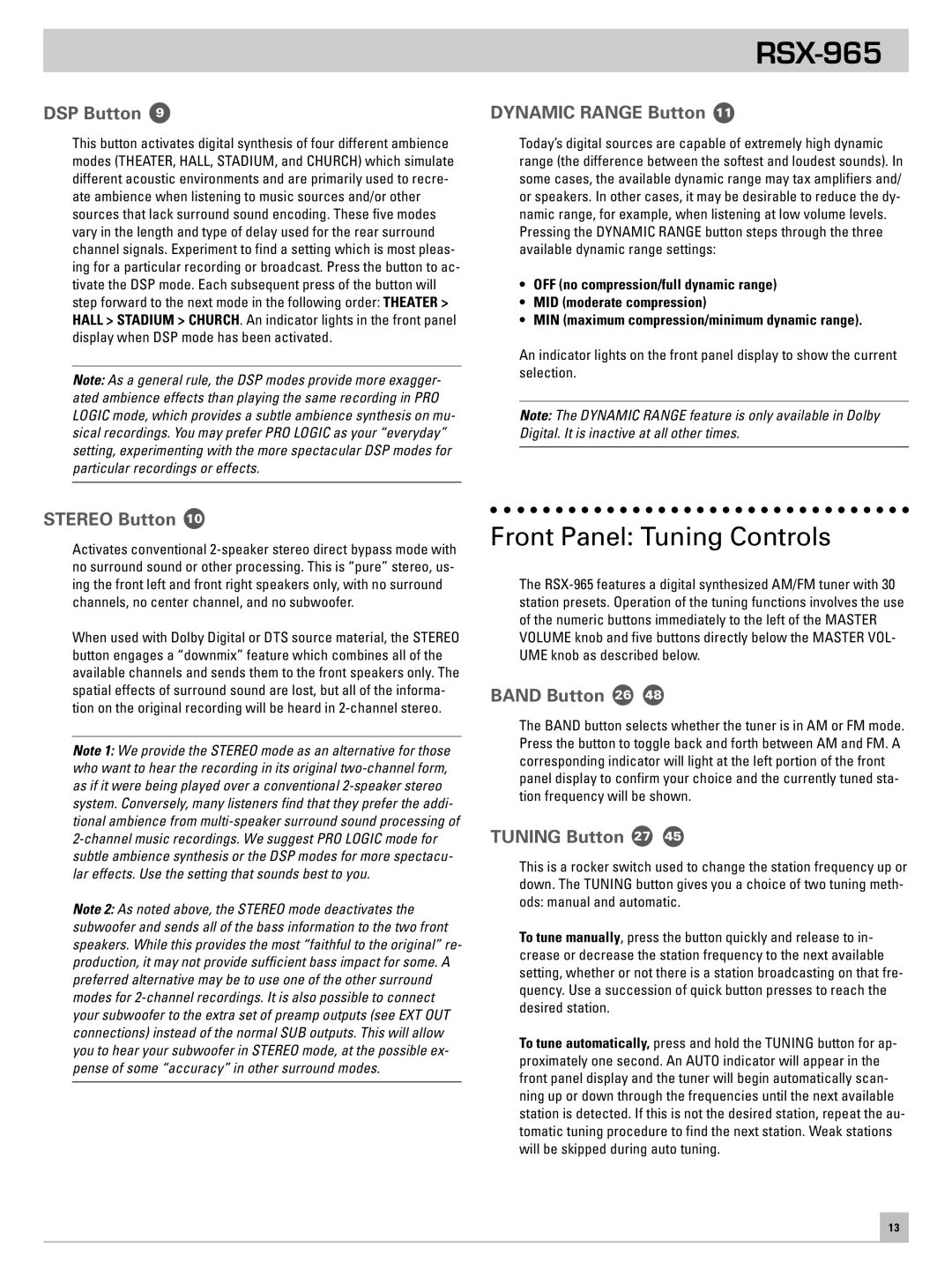
DSP Button 9
This button activates digital synthesis of four different ambience modes (THEATER, HALL, STADIUM, and CHURCH) which simulate different acoustic environments and are primarily used to recre- ate ambience when listening to music sources and/or other sources that lack surround sound encoding. These five modes vary in the length and type of delay used for the rear surround channel signals. Experiment to find a setting which is most pleas- ing for a particular recording or broadcast. Press the button to ac- tivate the DSP mode. Each subsequent press of the button will step forward to the next mode in the following order: THEATER > HALL > STADIUM > CHURCH. An indicator lights in the front panel display when DSP mode has been activated.
Note: As a general rule, the DSP modes provide more exagger- ated ambience effects than playing the same recording in PRO LOGIC mode, which provides a subtle ambience synthesis on mu- sical recordings. You may prefer PRO LOGIC as your “everyday” setting, experimenting with the more spectacular DSP modes for particular recordings or effects.
RSX-965
DYNAMIC RANGE Button 11
Today’s digital sources are capable of extremely high dynamic range (the difference between the softest and loudest sounds). In some cases, the available dynamic range may tax amplifiers and/ or speakers. In other cases, it may be desirable to reduce the dy- namic range, for example, when listening at low volume levels. Pressing the DYNAMIC RANGE button steps through the three available dynamic range settings:
•OFF (no compression/full dynamic range)
•MID (moderate compression)
•MIN (maximum compression/minimum dynamic range).
An indicator lights on the front panel display to show the current selection.
Note: The DYNAMIC RANGE feature is only available in Dolby Digital. It is inactive at all other times.
STEREO Button 10
Activates conventional
When used with Dolby Digital or DTS source material, the STEREO button engages a “downmix” feature which combines all of the available channels and sends them to the front speakers only. The spatial effects of surround sound are lost, but all of the informa- tion on the original recording will be heard in
Note 1: We provide the STEREO mode as an alternative for those who want to hear the recording in its original
Note 2: As noted above, the STEREO mode deactivates the subwoofer and sends all of the bass information to the two front speakers. While this provides the most “faithful to the original” re- production, it may not provide sufficient bass impact for some. A preferred alternative may be to use one of the other surround modes for
Front Panel: Tuning Controls
The
BAND Button 26 48
The BAND button selects whether the tuner is in AM or FM mode. Press the button to toggle back and forth between AM and FM. A corresponding indicator will light at the left portion of the front panel display to confirm your choice and the currently tuned sta- tion frequency will be shown.
TUNING Button 27 45
This is a rocker switch used to change the station frequency up or down. The TUNING button gives you a choice of two tuning meth- ods: manual and automatic.
To tune manually, press the button quickly and release to in- crease or decrease the station frequency to the next available setting, whether or not there is a station broadcasting on that fre- quency. Use a succession of quick button presses to reach the desired station.
To tune automatically, press and hold the TUNING button for ap- proximately one second. An AUTO indicator will appear in the front panel display and the tuner will begin automatically scan- ning up or down through the frequencies until the next available station is detected. If this is not the desired station, repeat the au- tomatic tuning procedure to find the next station. Weak stations will be skipped during auto tuning.
13
